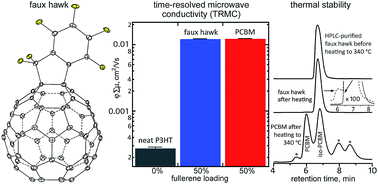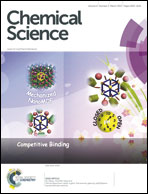A faux hawk fullerene with PCBM-like properties†
Abstract
Reaction of C60, C6F5CF2I, and SnH(n-Bu)3 produced, among other unidentified fullerene derivatives, the two new compounds 1,9-C60(CF2C6F5)H (1) and 1,9-C60(cyclo-CF2(2-C6F4)) (2). The highest isolated yield of 1 was 35% based on C60. Depending on the reaction conditions, the relative amounts of 1 and 2 generated in situ were as high as 85% and 71%, respectively, based on HPLC peak integration and summing over all fullerene species present other than unreacted C60. Compound 1 is thermally stable in 1,2-dichlorobenzene (oDCB) at 160 °C but was rapidly converted to 2 upon addition of Sn2(n-Bu)6 at this temperature. In contrast, complete conversion of 1 to 2 occurred within minutes, or hours, at 25 °C in 90/10 (v/v) PhCN/C6D6 by addition of stoichiometric, or sub-stoichiometric, amounts of proton sponge (PS) or cobaltocene (CoCp2). DFT calculations indicate that when 1 is deprotonated, the anion C60(CF2C6F5)− can undergo facile intramolecular SNAr annulation to form 2 with concomitant loss of F−. To our knowledge this is the first observation of a fullerene-cage carbanion acting as an SNAr nucleophile towards an aromatic C–F bond. The gas-phase electron affinity (EA) of 2 was determined to be 2.805(10) eV by low-temperature PES, higher by 0.12(1) eV than the EA of C60 and higher by 0.18(1) eV than the EA of phenyl-C61-butyric acid methyl ester (PCBM). In contrast, the relative E1/2(0/−) values of 2 and C60, −0.01(1) and 0.00(1) V, respectively, are virtually the same (on this scale, and under the same conditions, the E1/2(0/−) of PCBM is −0.09 V). Time-resolved microwave conductivity charge-carrier yield × mobility values for organic photovoltaic active-layer-type blends of 2 and poly-3-hexylthiophene (P3HT) were comparable to those for equimolar blends of PCBM and P3HT. The structure of solvent-free crystals of 2 was determined by single-crystal X-ray diffraction. The number of nearest-neighbor fullerene–fullerene interactions with centroid⋯centroid (⊙⋯⊙) distances of ≤10.34 Å is significantly greater, and the average ⊙⋯⊙ distance is shorter, for 2 (10 nearest neighbors; ave. ⊙⋯⊙ distance = 10.09 Å) than for solvent-free crystals of PCBM (7 nearest neighbors; ave. ⊙⋯⊙ distance = 10.17 Å). Finally, the thermal stability of 2 was found to be far greater than that of PCBM.


 Please wait while we load your content...
Please wait while we load your content...